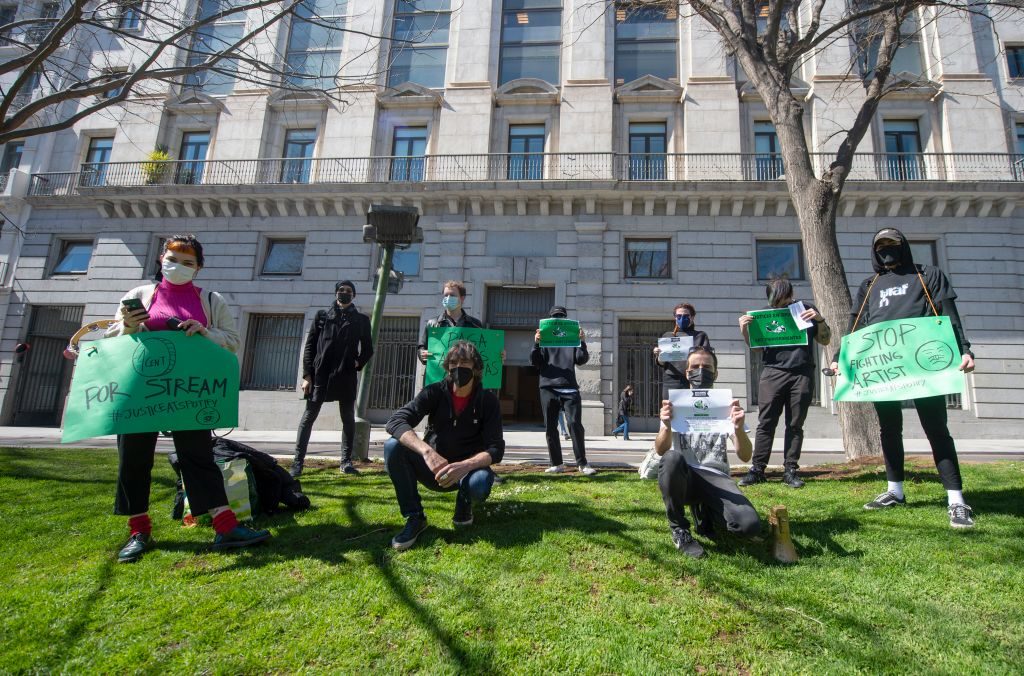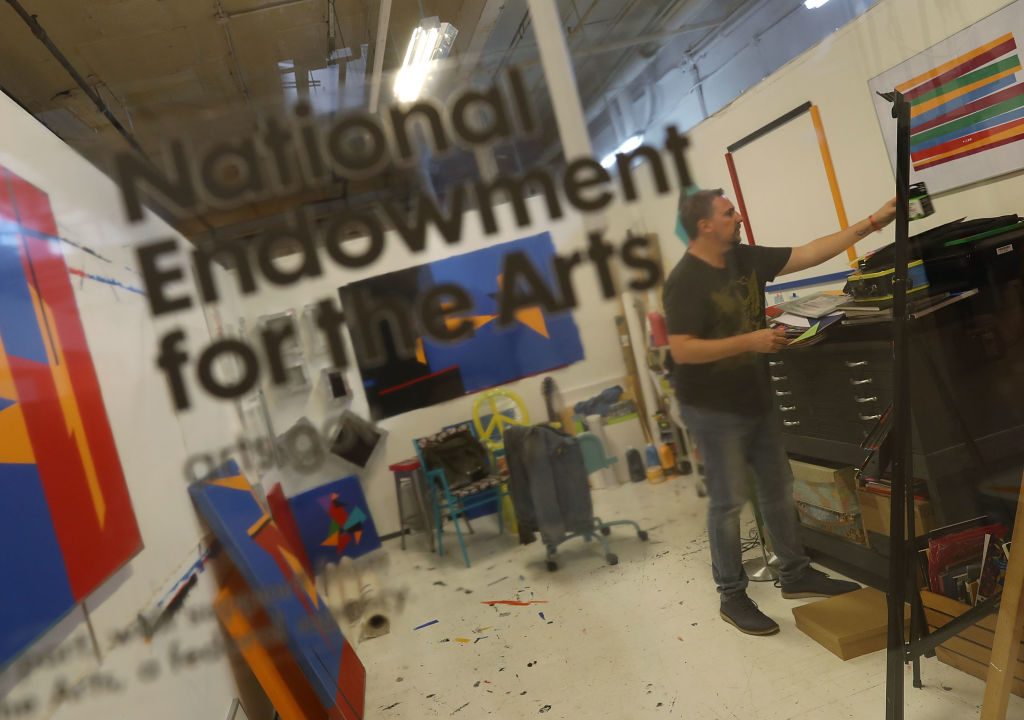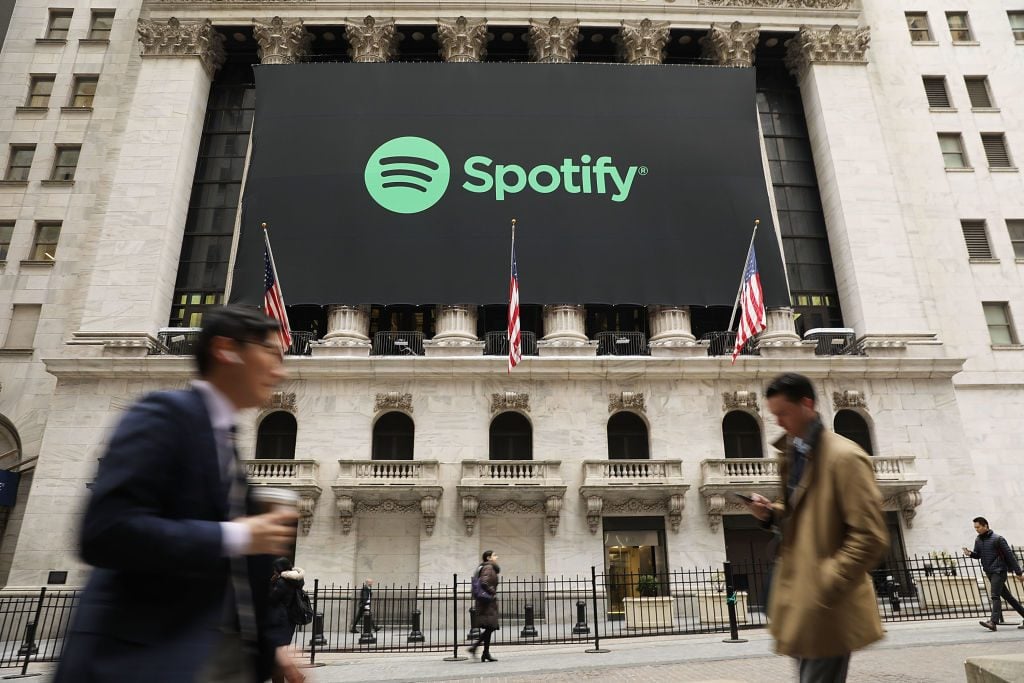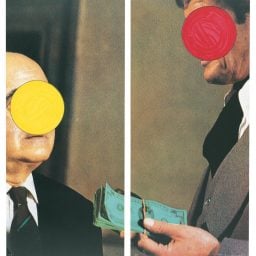Every Wednesday morning, Artnet News brings you The Gray Market. The column decodes important stories from the previous week—and offers unparalleled insight into the inner workings of the art industry in the process.
This week, asking which advances qualify as genuine progress…
A STREAM, OR A NIGHTMARE?
Last Friday, Ben Sisario of the New York Times laid out some noteworthy developments in the international effort to make the music-streaming economy more equitable to artists. The state of play there underscores how ossified the systems for distributing and compensating visual art remain in 2021. But the comparison also invites a very serious question about whether visual artists are actually worse off as a result—as well as whether that question misses the point entirely.
Sisario’s piece largely centers on the U.K., where the British Parliament’s Digital, Culture, Media, and Sport Committee began investigating the business of streaming in October 2020. He writes that the group’s “aggressive questioning of tech and record executives” has “riveted the industry” throughout the proceedings, which will end with a formal report likely to be issued “in the coming weeks.”
The core issue is simple on the surface, but extremely tangled deeper down. More than 12 years after Spotify made landfall in the U.K. (and nine years after it did the same in the U.S.), streaming has emerged as the dominant channel for global music consumption. Sisario relays that Spotify alone counts more than 356 million users worldwide, including 156 million paying subscribers, and has funneled more than $5 billion in revenue to rights holders (meaning record labels, artists, and other entities that control artist’s catalogs) in 2020.
Despite abundant rhetoric about the democratizing force of the streaming platforms, however, it turns out they have been most effective in rebuilding the fortunes of the record labels—the very gatekeepers whose power was supposed to be most radically redistributed to artists in the on-demand music era.
According to Sisario, “industry estimates put Spotify’s payout rate for recordings at… less than half a cent per stream” for the average artist. Worse, “since that money may pass through a record company before making its way to an artist, hundreds of millions of streams may be needed for a musician to net anything substantial.”
This is a big reason why, after a miserable run for most of the still-young 21st century, the labels are back to racking up what Sisario termed “huge profits” while most non-star artists fail to generate anything resembling a living wage. Based on a recent study by Spotify, he estimated that more than 60 percent of some 472,000 professional musicians earned under $1,000 from the platform last year.
Dozens of marquee names in music have been advocating for systemic change alongside the rank and file. In April 2021, a 150-strong coalition of U.K.-based artists (ranging from elder statespeople Paul McCartney, Annie Lennox, and Boy George, to Coldplay frontman Chris Martin, fast-rising avant-jazz virtuoso Shabaka Hutchings, and acclaimed disco revivalist Jessie Ware) signed a joint letter urging British prime minister Boris Johnson to reshape the laws governing Spotify, Apple Music, and other platforms’ remuneration schemes.
Almost no one familiar with the art market would argue in good faith that its machinery is optimized for either the benefit of the average artist or the technological possibilities of the age. And yet, in light of the streaming economy’s grossest inequities, I had a bizarre thought: are contemporary artists actually… better off precisely because the business has been slower to evolve than music?
I think the answer might be “yes.” But I also think “yes” isn’t enough.

At a worldwide rally by the Union of Musicians and Allied Workers, several musicians demonstrate in front of Spotify’s headquarters on March 15th, 2021, in Madrid, Spain. (Photo by Alberto Ortega/Europa Press via Getty Images)
SPLIT DECISION
When comparing the art and music industries, the best way to incinerate the “grass is always greener on the other side” fallacy would be to find someone who has firsthand experience in both yards. Fortunately, we have that someone in Issy Wood.
Collectors, dealers, and curators primarily know Wood as an ascendant painter who can imbue subjects ranging from celebrity portraits to surreal still lifes with an antic mix of unease and humor. But she also makes intriguing, off-kilter pop music as a signee to super-producer Mark Ronson’s Zelig Records imprint. (Her latest single, “Muscle,” landed in April.) Her double life gives her a unique perspective on the relative merits of each industry.
In an interview last year, Wood told my colleague Naomi Rea that, “after a year of legal back-and-forth with Sony and a ton of copyright issues concerning the visuals I’ve made to accompany the music… I kind of agree” with the notion that the art game feels “ethical” in comparison to the music game. She went on to say:
In art we don’t really do contracts, and that leaves only blind trust. Perhaps some artists have been screwed by this lack of paperwork, but I’ve really benefited from it. The 50/50 sales split between artists and dealers has taken on an almost sacred status in my head, because the label to artist ratio is far more lopsided.
The longer portion of Wood’s quote clarifies that, when she called the art market “ethical,” she was concentrating on its economics rather than its behavioral norms. Aside from the two advantages she mentioned above, it’s arguable that contemporary artists also benefit from the art market’s structure as a niche economy based on selling relatively low numbers of scarce works with relatively high prices, not a mass market requiring millions of streams (or, in the CD era, millions of $9.99 album sales) for sustainability.
Yet relativism can be a dangerous game, too. If I tell you that Aaron Sorkin’s The Trial of the Chicago Seven is a more enjoyable watch than the live feed from a colonoscopy camera, that obviously does not mean I thought The Trial of the Chicago Seven is a good movie. Wood sounds more enthusiastic about the gallery system than that, but she’s also the rare contemporary artist whose opinion is colored by the simultaneous experience of creating a different type of work in a related industry that is even more unfavorable to talent. Context matters.
Outside the advantages above, the gallery system and the music industry share several strands of DNA. Each is still a star system that reflects what quants call a “power law,” meaning the vast majority of the resources, attention, and profits accrue to a small minority of artists and distributors. In the art world, those distributors are galleries, art fairs, and, to some extent, online platforms; in the music world, they are labels, promoters (like LiveNation), and streaming platforms.
All of which makes pursuing a career as an artist risky for most people regardless of their choice of medium. Between the grassroots artist advocacy and the parliamentary interrogation, Britain’s pressure campaign on Spotify and its rivals is just a more organized, broader-based, institutionally backed response to the same punishing conditions the art market metes out in miniature. In both markets, it would be hard to distill the average artist’s dilemma more effectively than a young Kanye West did in 2009: “having money ain’t everything / not having it is.”
Even if we accept that the art economy is at least somewhat more pro-artist than the music economy, then, it’s still a brutal business for the overwhelming majority of artists. So the operative questions here are the same as the ones driving potential reforms around streaming compensation abroad:
What could be done to raise the quality of life for so many artists straining to make a living despite having built a modest audience for their work? And whose responsibility is it to make those changes?

Claudio Roncoli, a recipient of an award from the National Endowment for the Arts, works in his studio space at the Bakehouse Art Complex on March 16, 2017 in Miami, Florida. (Photo by Joe Raedle/Getty Images)
DON’T WORRY ABOUT THE GOVERNMENT
Everyone reading this column agrees that artists as a class are inherently valuable to society. I’d go much further, though: I think practically everyone on earth agrees with that sentiment, even if they don’t recognize they do.
Sure, different groups can (and do!) scream at each other all day about which artists are valuable, and why. But if you gave 1,000 randomly selected people the choice, I bet 999 of them would rather see the side of a plain commercial building covered with a mural than a flat coat of gray paint (assuming you also gave them some reasonable assurance you weren’t slyly getting them to greenlight, say, a giant Bolshevik Cookie Monster). You don’t get those moments of visual enrichment without the people who make them.
Artists’ benefit to culture was especially apparent during last year’s shutdown. Around the U.S. and around the globe, people who were isolated at home and fearful about the future found escape, solace, and joy in works that artists went out into the world to produce for that exact purpose. They also often did so at their own expense and personal risk—both of which were considerable, given that artists receive no specific income or healthcare protections here in the states.
It’s a prototypically American bargain: provide a public service, but depend on the market to make it viable. But in art and in music, the market is proving increasingly unfit for the role in most cases.
The parallel is clearer than ever to Kendra Jayne Patrick, who recently returned to New York after months of running her itinerant gallery from Europe, including connecting with socially minded artists like Gernot Bubenik, a cofounder of the German Artist Pension. Whether we’re talking about providing a sufficient number of hospital beds or a sustainable wage for a widely valued service, “It’s not the corporation’s job to think about wellbeing. That’s the government’s job,” she said. “I think that includes artists and having dignified lives.”
Given that most music is now streamed instead of purchased, Patrick sees particular convergence between the plight of musicians and the plight of contemporary artists working in digital media. Many members of the latter group are increasingly thinking about how they can be paid for their labor, not their output, she said, because a “lack of respect for digital makers” inside collecting circles means most software-based artworks remain unlikely to sell.
Yet we know this is true on a grander scale, too: most artworks, period, remain unlikely to sell. But a small subset sells multiple times on the resale market, for earth-shaking prices, with only the owner-turned-seller directly profiting from the upside.
This imbalance long ago motivated the U.K., France, and others abroad to legislate their own resale royalty right for artists based inside their borders. In general, these regulations require a small percentage of net profit on the resale of an artwork to be channeled back to the artist themselves. The British version, for example, caps resale royalty for its residents at €12,500 (about $17,300), no matter how much money a work fetches when it returns to market.
Concerned members of the U.S. art industry have pushed for various domestic variations on the rule at times, to no lasting success. California was the only state to ever impose a resale royalty, but it was struck down in the courts once and for all in 2018 save for works sold during a certain one-year period in the late 1970s.
Still, even mirroring Europe’s resale royalty would not solve the structural problem faced by most artists. At best, it only creates a feedback loop benefiting the few artists who are already successful enough for their output to have generated demand on the secondary market. It does nothing to assist the thousands of artists hoping to somehow scrape together a living to continue doing what they do.
Brian L. Frye, a law professor at the University of Kentucky who has studied art-market resale royalties for years, argued in a 2017 paper that the most equitable variant would act as a progressive tax on secondary-market sales—one designed to favor the people who most need the revenue it generates. As he explained to me, “a resale royalty is just a peculiar sales tax that goes to the author of an artwork. Normally, we think tax revenue should be used for the purpose of socially beneficial redistribution. Why should a resale royalty tax be any different?”
In Frye’s thinking, a progressive resale royalty for artists could be redistributed to commercially unsuccessful artists as either direct transfer payments, or as general funding for the visual arts domestically. But in both cases, the most efficient way to administer the programs would be the same: the federal government.
In the first instance, the IRS already has identification and income records for everyone who claims “artist” as a profession (or runs a small business to that effect) on their tax returns, putting the agency in the best position to determine who qualifies for direct assistance and how best to pay them. If the U.S. took the public funding route instead, resale royalties could be funneled into the National Endowment for the Arts and National Endowment for the Humanities, whose entire missions are to judge where money can do the most cultural good for citizens nationwide.
Either outcome is still wishful thinking in 2021. Among the other distinctions between the art and music economies, then, the most consequential difference concerns the political response to the widespread inequity facing artists.
Only time will tell if Britain’s parliament and prime minister will require reforms from Spotify and its rivals. Still, musicians’ advocacy has moved both to at least interrogate the streaming platforms’ compensation standards, precisely because those standards increasingly endanger the class producing a form of culture seen as inherently valuable to everyone. Visual artists have not benefited from the same targeted concern about their market yet, either here or abroad.
Since pop music likely means more to the average citizen than visual art, changing that situation would be a tall task. Until it happens, visual artists might be slightly better off working in a niche, sales-based market than their musical counterparts receiving fractions of pennies for working in a mass streaming one. But even if so, “it could be worse” is a hard chorus to sing with feeling forever.
[The New York Times]
That’s all for this week. ‘Til next time, remember: as any bandleader will tell you, getting loud means nothing if you don’t also get organized.









